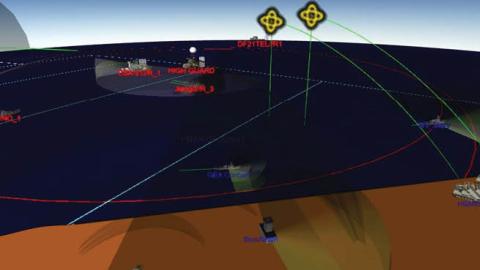The Pentagon’s effort to develop Joint All Domain Command and Control has refocused attention on an essential but unheralded enabler that makes military operations possible. Processes and capabilities for command, control, and communications—or C3—connect armed forces and allow leaders to make and promulgate decisions. An effective C3 architecture, like a good logistics system, provides troops, ships, and aircraft what they need, when they need it, without taking commanders’ attention away from the mission.
C3 schemes need to accommodate a wide range of potential future scenarios, force compositions, threats, and environmental conditions. One path to this robustness is building communications networks that can withstand attacks, jamming, and electromagnetic deception to enable a fixed hierarchical command structure. Although the Pentagon’s JADC2 strategy is not public yet, DoD leaders continue to emphasize this network-centric approach, despite its likelihood of falling short against capable opponents like China’s People’s Liberation Army.
Our recent study for DARPA determined that a better strategy for DoD C3 would adapt command relationships to communications availability rather than attempting to field networks that support a desired C2 architecture. This approach would help improve the optionality possible with a deployed force and is embodied in the concept of mission command, where field commanders are delegated authority to carry out senior leaders’ intent.
Mission command is the future of C3
Today, mission command is treated as the U.S. military’s fallback decision-making approach when front-line units are cut off from higher headquarters. Instead, mission command should be the U.S. military’s primary C2 process.
Mission command can yield more options for U.S. commanders and impose more uncertainty on opponents compared to today’s reliance on centralized command and decentralized execution. The choices available to senior leaders in far-away operating centers will be limited by the need to select courses of action several steps ahead in case contact is lost with field commanders. In contrast, mission-type orders keep more options open longer by delegating and deferring decisions on the exact timing and orchestration of actions to subordinates in the field with more accurate and timely information. Moreover, the diversity of junior leaders’ choices will force the enemy to defend against a wider array of potential courses of action.
Mission command can help provide U.S. forces a competitive edge against opponents like China’s People’s Liberation Army without having to rely on ever more expensive military hardware. The PLA’s concept of Systems Destruction Warfare is built on the idea that U.S. military systems of systems and tactics are predictable. By delegating most decision-making to field commanders, U.S. forces would increase the likelihood of emergent and unpredictable behavior that will undermine the PLA’s ability to prepare countermeasures and tactics.
Embracing mission command as the default C3 approach would also address the impacts of an increasingly contested and congested electromagnetic environment. The Internet-of-Things model of military C3 advanced in early versions of the Air Force’s Advanced Battle Management System could work well in a benign environment, but against a capable adversary like China, it is unlikely U.S. C3 will be able to reliably connect every sensor, shooter, and commander. Command relationships would need to adapt to communications availability, but when contact is restored, subordinate commanders’ situational awareness and actions can be shared among their peers and aggregated for headquarters planners managing theater operations over longer timescales. 
Creating optionality
Mission command will require new decision support technologies to give front-line commanders an optionality advantage relative to opponents. For example, network management systems like DARPA’s DyNAMO are needed to connect field commanders with the forces they can reach despite enemy jamming, including those using different radio systems. The resulting “heterarchical” networks organize around commanders who can connect with the most units needed for the force’s overall missions, improving resilience compared to today’s hierarchical networks.
Field commanders established by network management systems will have difficulty quickly formulating courses of action using a changing array of forces. They will need battle management tools, some of which are under development today, that can propose tactics and force compositions that pursue objectives, attempt to maximize current and future options, and constrain enemy choices.
Rapidly developing courses of action for changing circumstances that address multiple, competing objectives under changing circumstances will likely be infeasible if battle management systems develop each set of tactics and force compositions from scratch. Tools could instead use analogous problem-solving, in which “playbooks” of courses of action from previous real or simulated operations provide the starting point for artificial intelligence-enabled algorithms to refine an approach for a current mission.
Decision support systems that empower mission command are already providing value, even in a developmental form. Because mission command occurs on a spectrum between centralized C2 and fully empowered subordinates, field commanders will be able to exert more autonomy as software improves for network management, interoperability, and battle management. Integrated development and operations of decision support tools will continue to grow the optionality available to leaders exercising mission command.
The U.S. military is arguably falling behind in its military competition with the PLA, but JADC2 could give U.S. forces an edge by improving their adaptability and resilience while imposing complexity and uncertainty on adversary decision-making. To gain that competitive advantage, however, JADC2 will need to elevate C2 by embracing mission command and optionality instead of building a brittle Internet of Things that will collapse in the face of a capable opponent.
Read in RealClearDefense



















